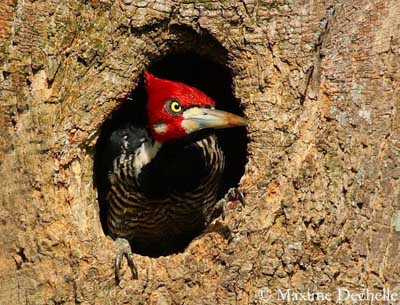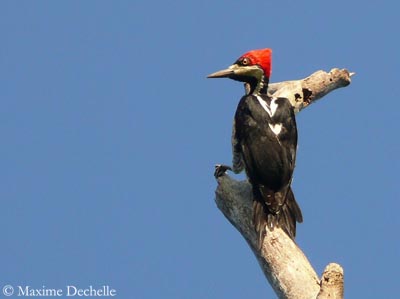
Crimson-crested Woodpecker
Campephilus melanoleucos
Piciforme Order – Picidae Family
BIOMETRICS:
Length: 33-38 cm ; Weight: 180-285 g
DESCRIPTION:
Crimson-crested Woodpecker is a large woodpecker living in very wide ranges of habitats.

Adult male has black upperparts with conspicuous white stripes on each neck side, descending on the sides of mantle, and joining in centre of the back, forming a white V. We can see some small black spots on the white stripe on the back. Upper wing and upper tail feathers are black.
Female Crimson-crested Woodpecker resembles male, but she has black forehead and slightly larger crest than male. Centre of the red crest is black. She has a broad whitish malar stripe, extending downwards to the neck sides.
Juvenile has browner plumage on upperparts, and darker on underparts, with heavier barring. It has mostly pinkish-red head with the same pattern as adult female and whitish supercilium.
Young male acquires much red very soon. It reaches its sexual maturity at one year.
VOICE: SOUNDS BY XENO-CANTO
Crimson-crested Woodpecker utters two typical nasal calls: a vibrating, loud “chis-sic”, and a longer “tttt-he-he-he”.
Both sexes drum, male more than female during breeding season.
HABITAT:
Crimson-crested Woodpecker lives in varied types of habitats, but it needs trees. It is found in cloud forest, rainforest, gallery forest, open woodlands and savannah. It also frequents clearings and forest edges, plantations, pastures and wetlands. According to the country, this species can be found from lowlands to 2500 metres of elevation, locally up to 3000 metres in the Andes.
Crimson-crested Woodpecker can be seen sometimes perched in isolated tree away from the forest.
RANGE: Crimson-crested Woodpecker is resident from Panama to northern Argentina and south-eastern Brazil, and in Trinidad.
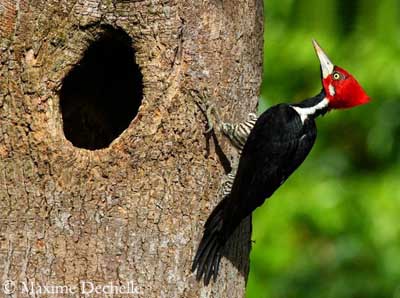
DIET:
Crimson-crested Woodpecker feeds mainly on wood-boring insects and larvae, ants, termites, small invertebrates and caterpillars. It also consumes berries.
It gets its prey by giving strong blows against the bark with its bill, in order to remove chips of wood and bark to extract the invertebrates which are into the trunk. It also probes in natural cavities.
PROTECTION / THREATS / STATUS:
Crimson-crested Woodpecker populations are not globally threatened. It is relatively common in most parts of its range.
Fr: Pic de Malherbe
All : Schwarzkehlspecht
Esp : Picamaderos Barbinegro
Ital : Picchio bianco e nero
Nd : Zwartkeelspecht
Photographs 1 and 3 by Maxime Dechelle
LEPAPARRAZO
Photograph 2 by Alfredo Colón
Puerto Rico Wildlife
Text by Nicole Bouglouan
Sources :
HANDBOOK OF THE BIRDS OF THE WORLD Vol. 7 by Josep del Hoyo-Andrew Elliott-Jordi Sargatal – Lynx Edicions – ISBN: 8487334377
A GUIDE TO THE BIRDS OF COLOMBIA by Steven L. Hilty and William L. Brown
Princeton University Press – ISBN 069108372X
Arthur Grosset's Birds (Arthur Grosset)
Birds in Suriname, South America (Jan Hein Ribot)
Discovering the birds of Trinidad and Tobago (Brian Ramsey)
Wikipedia (Wikipedia, The Free Encyclopedia)
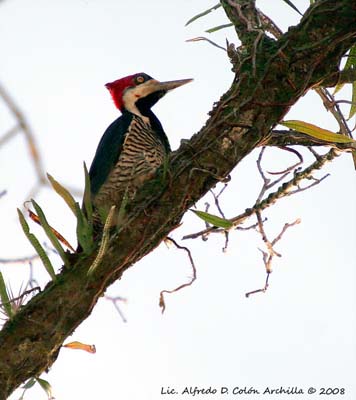
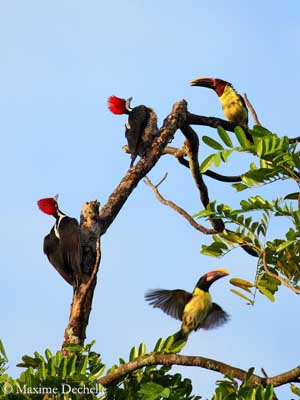
FLIGHT:
Crimson-crested Woodpecker performs strong undulating flight.
REPRODUCTION:
Breeding season depends on the locality.
Crimson-crested Woodpecker nests in holes excavated by both adults, relatively high in trees or stubs. The entrance is fairly large, about 45 to 50 cm in diameter, and oval-shaped.
Female lays 2 to 3 white eggs, sometimes four. Incubation lasts about 9 to 14 days, by both sexes. Woodpeckers have short incubation period, but at contrary, nesting period is longer than in other birds’ species. Chicks are brooded and fed by both parents, and remain at nest for 3 to 4 weeks after hatching. Young remain within the family group until next breeding season.
